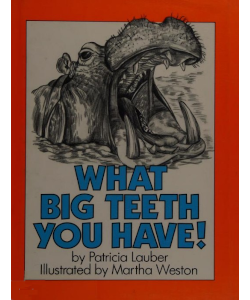What Big Teeth You Have!

Author:
Patricia Lauber
Illustrator:
Martha Weston
Publication:
1986 by HarperCollins
Genre:
Nature, Non-fiction, Science
Pages:
60
Current state:
Basic information has been added for this book.
It is under consideration and will be updated when it is evaluated further.
Book Guide
Search for this book used on:
*in five years a tiger shark may form, use and lose 12,000 teeth
*an elephant's tusks (which are really teeth) may grow to be 10 feet long and weigh 125 pounds each
"a flying fox bat can use its teeth to break open a small coconut
Like tools, animal teeth have many shapes. Each shape is suited to doing a certain kind of job—tearing, gnawing, nibbling, grinding. And so an animal’s teeth are clues to the kind of food it eats and how it catches or gathers that food. Lions and wolves have big, sharp teeth. These animals are hunters. Horses are grass-eating animals. They have broad, flat teeth suitable for grinding their food.
Teeth provide other information. One way scientists classify an animal is by studying its teeth. Closely related species have similar kinds of teeth. For example, beavers and chipmunks both have four self-sharpening incisors that help classify them as rodents, or gnawing mammals. Studying animal teeth can give scientists clues to the past, too. How do we know what dinosaurs ate? By studying their teeth!
What Big Teeth You Have! introduces readers to an intriguing new way of looking at animals.
From the dust jacket
To view an example page please sign in.
Find This Book
Search for this book used on:


